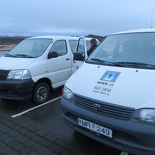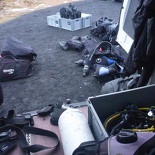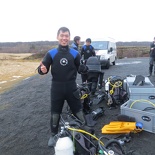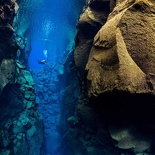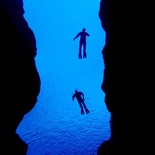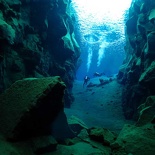Iceland is Europe’s westernmost country and home to one of the top 5 dive sites in the world. My dive adventure started off setting off the local commercial dive center and getting to know my dive master for the day who will be taking the dive group for Scuba diving in lake Silfra. The specific area of interest will be the Silfra crack in Thingvellir Lake, National Park Thingvellir. Iceland being geographically situated on the edge of the Arctic Circle, occupies a strategic location in the North Atlantic.
This makes it not only one of the coldest countries in the world to dive in recreationally, but also one of the world’s most volcanically active hotspots which makes dry-suit diving a very viable option here. If you are SCUBA trained, you can do a leisure dive with a local dive master who takes on dive groups starting at 2 divers per instructor.
If you do not have a diving license, you can opt for a surface snorkeling sessions (Up to 5 per instructor). A number of my travel buddies are not SCUBA certified, so you do not miss out of the adventure completely. Both modes require you to don a dry suit with the SCUBA option allowing you to explore the tectonic fissure by swimming right between the gorges, it is also the more scenic route as you are not limited to just what you can see on the surface of the lake. Silfra is also the only few places in the world where you can get a Tectonic plate diver PADI card.
Silfra in Thingvellir
Silfra is this fault line between these two Earth’s tectonic plates which gave birth to such amazing rock features in the Thingvellir National Park. This fault line is unlike that in other active tectonic areas, particularly Japan pacific plate or California’s San Andreas. Thingvellir is the only area in the world where you get glaciers feeding two separate continental plates. Specifically the plates in question are the North American plate and Eurasia plates. They are slowly drifting apart at the mid-Atlantic ridge, causing Iceland to naturally grow larger over time at a rate of 2cm a year. No wonder, it has been declared a world heritage site by UNESCO.
The diving site is rather remote itself, involving under a 2 hour drive from Reykjavík on the south west of the island deep into the heart of the Icelandic wilderness, and into geo-thermal territory beaming with tectonic plate activity. Iceland itself is a very active volcanic region with 18 active volcanoes. Upon entering the national reserve, you will notice several odd geological features in the area, particularly large fissure cracks and sheared rocks typical of that between two tectonic plates. We found a small sizable holding area to park our vehicles where we can unload all our SCUBA and snorkeling gear required for the dive.
You enter Silfra via a small access metal staircase located by the side of a small stream (Silfra rift) at the start of the river tributary leading into the main body of Silfra lake. The dive started off with a short, but otherwise rather taxing walk on land with our full SCUBA gear and weight belts from the landing area across a road to the entrance platform leading into the crack. Upon entering the water, you do not get the usual taste of salty sea water, but otherwise fresh tasteless drinkable glacier melt. The clean water is also much friendlier to your SCUBA equipment than what sea water does in degradation. The water here is also said to be clean enough to drink directly. No more risk of ingesting sea water from a random freak open-water waves
Silfra consists of 5 main sections, the Silfra rift and entrance, Silfra Hall, the Silfra Cathedral, the Silfra Lagoon, and an underwater cave area known as the little crack. The Silfra entrance and Hall dive sections are used by both divers and snorkelers alike. If you are underwater, you can often see the underwater scenery mirror from the surface as if you were diving through a tunnel, so it pays often to be aware of people diving or directly above you at all times when diving underwater.
Drysuit diving
It was my first time diving in Drysuit too. Dry suit diving in colder waters is essential particularly to reduce the amount of heat loss. After a small series of familiarization dives to get used to the buoyancy of your dry-suit, we went down to maximum depth of 18 meters. Dry suit diving is unlike wet suit, where you dive in a completely sealed suit. This creates additional challenges as air can be potentially trapped in the various pockets throughout your dry suit which can lead to uneven buoyancy issues, such as air pocketed accumulation.
You do not use your BCD at all during dry suit diving. The good is that you can wear anything under the suit completely protected from the water, which in my case were layers of winter jackets for insulation from the sub-zero freezing water.
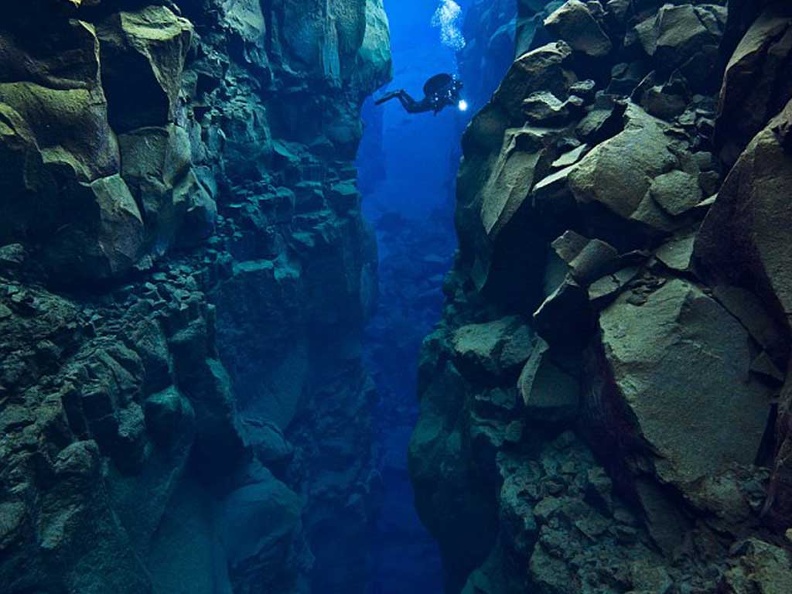
Silfra’s is a small crack area which runs parallel to the mid-Atlantic ridge within the lake itself. The diving experience itself is not only unique, but exclusive and not for the faint of heart too as the area is an active tectonic region with many possible plate and rock movements. You are technically surrounded on both sides by steep dark gorges, with walls going up to 50 m on both sides underwater with the American and Eurasian continents on either side.
As you go along the hall, you can see in the deep abyss below you many remnants of collapsed caves too with many large boulders all sewn around the crack floor. These collection of rocks on the bottom the Silfra Hall look like they had been accumulated over time, with some of them looking freshly displaced. The danger is real too as the place is known to have random and frequent small earthquakes occurring. There were many loose rocks and forming much of the caves features within the crack, you won’t want to be caught in a sea of falling rocks.
Silfra Cathedral
Moving along Silfra Hall at the end of the cathedral, you will get a mild current when entering the vast lagoon from an small entry point. This is caused by the current of underground wells which set upon the undersea movements of the lake. As the lake is largely enclosed, you seldom get much of a strong current, giving it a very chill and tranquil relaxing atmosphere.

Silfra Lagoon
Diving in the clear glacier waters, particularly in the lagoon area yields an underwater visibility exceeding an astonishing 100m. The water here is very clean as it comprises all of melted glacier water originating from a nearby glacier 50 km away.
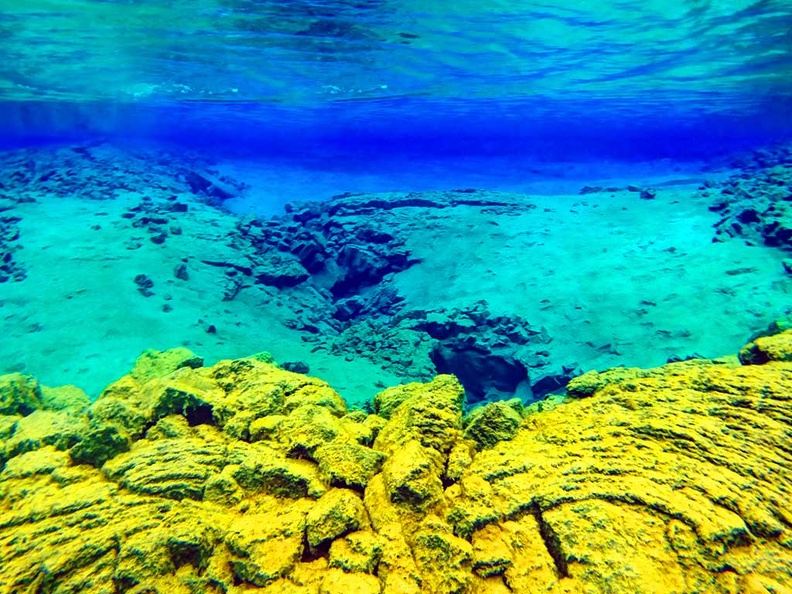
The water which flows into Silfra is not only fresh from the source, but it is too extensively filtered through underground wells and porous rocks in the lava fields through the lake’s natural internal circulation currents leading into in Thingvellir lake.
Bolstering your dive licenses – PAID drysuit diver
At the end of my dive, I obtained both my Drysuit and Tectonic Plate diving licenses. As such, I am officially not only NAUI scuba diving trained but additionally PADI trained now too (which the dive center being a PADI dive center too). This was pretty much a welcome to me being cross-trained with the more internationally recognized NAUI SCUBA license at my first license to start, and topping up the “achievement badges” with the more commercialized PADI ones.
Being PADI Dry-suit certified also means it is easier for me to rent SCUBA equipment worldwide too, especially Dry-suits with the Drysuit license, given as there are more PADI dive centers worldwide.
PADI Tectonic diver license
In addition, the tectonic awareness course teaches means of recognizing dangerous fissure features, volcanic features and particularly caves which are often unstable. It is a certification of safe diving done right here in Silfras itself which you can simply just include into your leisure dive without affecting your dive plan much. You of course, have to go through some theory lessons with your instructor at the dive center beforehand to have a prior understanding of what you will encounter during your actual tectonic dive in Silfras.
As such, the tectonic license is a very unique one indeed and diving in Iceland here is the only place in the world to obtain that PADI license. This card does not serve much of a practical use as what my dive buddy said (who got one himself), and only much used as an item for bragging rights that you had dived in Iceland and possibly one of the best dive sites in the world.
Talking about the cleanliness of the dive site water, this is possibly one of the only few times where I can actually drink the pristine water you are diving anytime during the dives.
Despite not seeing any fishes seen in my dive, as with any responsible diver, it pays not to interfere or disrupt much of the natural environment both for its cultural & historical significance as well as natural & geological uniqueness. The place is beautiful in its own natural right and I won’t want to see the influx of divers destroying such a pristine environment.
A typical dive won’t last longer than one hour which can only be done in the day for safety reason. My dive session was done in about an hour and half including the dry suit and tectonic diver certification lessons. A snorkeling session lasts about under one hour too. You will be good back in Reykjavík via van within 4-5 hours from your departure time which makes a dive session pretty much a half-day commitment.
This will indeed be a dive to remember just for its beauty and danger.

